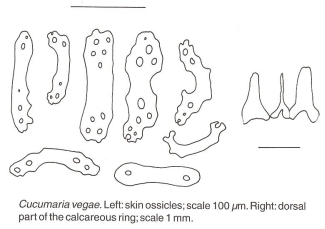Externally, Cucumaria vegae is identical to Cucumaria pseudocurata, but often a bit larger. The difference between them can only be determined by examining their skin ossicles. Even then, specimens from southeastern Alaska have ossicles that are intermediate between those from the Aleutian Islands and southern British Columbia. Analysis of mitochondrial DNA has shown that specimens occurring from the Queen Charlotte Islands to the Aleutians form a group that is about 2% different from the southern population we call Cucumaria pseudocurata, that lives from Vancouver Island south to California. For the time being, I will retain the existing names and propose that the name Cucumaria vegae be used for all specimens of this description found north of Queen Charlotte Sound.
Skin ossicles: vary from simple rods with a few holes, to rods that are expanded at the ends.
Similar SpeciesAs explained above, Cucumaria pseudocurata and C. vegae are similar and may not be a separate species. Pseudocnus curatus differs in the arrangement of its tube feet and the equal size of its tentacles.
